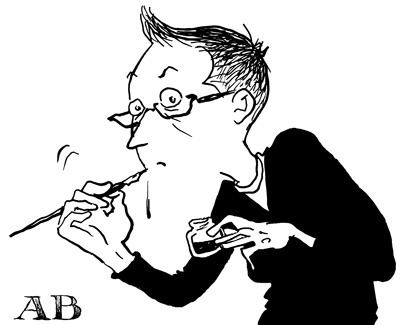

Volume 4, Issue 1: The Comics Work of Neil Gaiman.Volume 4, Issue 3: ImageSexT Proceedings.
 Volume 5, Issue 3: Convergences Proceedings. Volume 5, Issue 4: Alan Moore and Adaptation. Volume 6, Issue 2: ImageNext Proceedings. Volume 6, Issue 3: Shakespeare and Visual Rhetoric. Volume 7, Issue 1: Worlds of the Hernandez Brothers. Volume 8, Issue 1: Monsters in the Margins. Volume 9, Issue 2: Mixing Visual Media in Comics. Volume 10, Issue 3: Comics and Fine Art Forum. However, there are other, less obvious aspects to Fun Home that set it apart from the rest, things which readers should be aware. This book does serve as an important entry in LGBT canon building within the field of comics, and studying it from this perspective would be a worthwhile pursuit. This is no acquiescence to Bechdel’s claim that “literary criticism is a suspect activity,” as she essentially subjects herself to a form of meta-criticism. While it would be particularly relevant to analyze this book from the perspective of Queer Theory - the book is certainly well suited to such literary analysis - it is not something I am particularly interested in doing at this time. And make no mistake about it: there are times when readers would do well to bring their literary credentials with them when pitted against Bechdel.Īlison Bechdel’s memoir Fun Home contains many challenging experiences for readers, as she unfolds the details of her life as a young girl who discovers not only that she is a lesbian but also that her father is a closeted homosexual whose marriage to her mother proved stifling - at best - and downright damaging for everyone in the family. This novel expertly shows how comics are moving in new directions and demonstrates a willingness to engage readers in new and challenging ways. Alison Bechdel’s Fun Home is one such example of a graphic novel making use of comics as a means of opening a discourse about the scars family members leave on their children and finding some form of closure through sharing these stories with others. These writers and artists introduce readers to oft-times disturbing visual narratives, and since the reader is directly responsible for internalizing and synthesizing “action” in a comic, he or she is more directly engaged on a far more personal level than a cinematic representation would otherwise do where the audience simply views the film. Today, creators are taking advantage of this form to explore their own inner psychology. Comics as Catharsis: Alison Bechdel’s Fun Homeįun Home, like Chris Ware’s Jimmy Corrigan, the Smartest Kid on Earth and David Small’s Stitches, is an exceptionally complex graphic novel that explores the problematic nature of family and its effects on its creator, writes FORREST HELVIEĬomic literature is truly an exciting field, as it expands its canon to include more than the super-hero genre that got things started in the 1930s and ’40s.
Volume 5, Issue 3: Convergences Proceedings. Volume 5, Issue 4: Alan Moore and Adaptation. Volume 6, Issue 2: ImageNext Proceedings. Volume 6, Issue 3: Shakespeare and Visual Rhetoric. Volume 7, Issue 1: Worlds of the Hernandez Brothers. Volume 8, Issue 1: Monsters in the Margins. Volume 9, Issue 2: Mixing Visual Media in Comics. Volume 10, Issue 3: Comics and Fine Art Forum. However, there are other, less obvious aspects to Fun Home that set it apart from the rest, things which readers should be aware. This book does serve as an important entry in LGBT canon building within the field of comics, and studying it from this perspective would be a worthwhile pursuit. This is no acquiescence to Bechdel’s claim that “literary criticism is a suspect activity,” as she essentially subjects herself to a form of meta-criticism. While it would be particularly relevant to analyze this book from the perspective of Queer Theory - the book is certainly well suited to such literary analysis - it is not something I am particularly interested in doing at this time. And make no mistake about it: there are times when readers would do well to bring their literary credentials with them when pitted against Bechdel.Īlison Bechdel’s memoir Fun Home contains many challenging experiences for readers, as she unfolds the details of her life as a young girl who discovers not only that she is a lesbian but also that her father is a closeted homosexual whose marriage to her mother proved stifling - at best - and downright damaging for everyone in the family. This novel expertly shows how comics are moving in new directions and demonstrates a willingness to engage readers in new and challenging ways. Alison Bechdel’s Fun Home is one such example of a graphic novel making use of comics as a means of opening a discourse about the scars family members leave on their children and finding some form of closure through sharing these stories with others. These writers and artists introduce readers to oft-times disturbing visual narratives, and since the reader is directly responsible for internalizing and synthesizing “action” in a comic, he or she is more directly engaged on a far more personal level than a cinematic representation would otherwise do where the audience simply views the film. Today, creators are taking advantage of this form to explore their own inner psychology. Comics as Catharsis: Alison Bechdel’s Fun Homeįun Home, like Chris Ware’s Jimmy Corrigan, the Smartest Kid on Earth and David Small’s Stitches, is an exceptionally complex graphic novel that explores the problematic nature of family and its effects on its creator, writes FORREST HELVIEĬomic literature is truly an exciting field, as it expands its canon to include more than the super-hero genre that got things started in the 1930s and ’40s.








